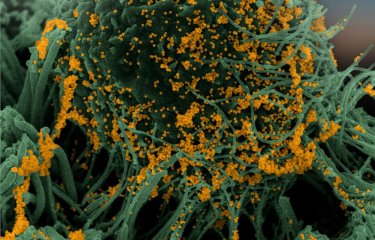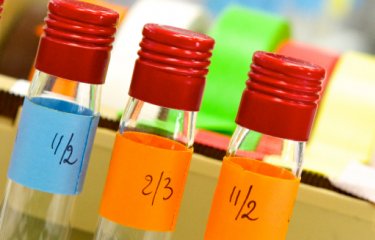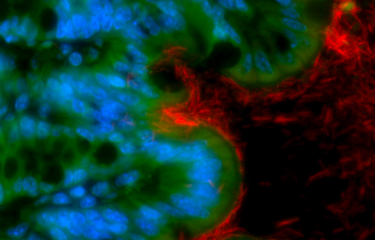In late April 2020, scientists at the Institut Pasteur, with the support of the Hauts-de-France Regional Health Agency and the Amiens Education Authority, carried out an epidemiological survey on 1,340 people linked to primary schools in Crépy-en-Valois, in the Oise department. Thanks to the cooperation of the people of Crépy-en-Valois, the survey, which made use of serological tests developed by the Institut Pasteur, revealed that the proportion of primary school students infected by the novel coronavirus was 8.8%. Based on some cases of infection detected in the students before the schools closed, it appears that the children did not spread the infection to other students or to teachers or other staff at the schools. The results were published online on pasteur.fr on June 23, 2020. The results were then published on April 15th, 2021 on Eurosurveillance.
- The virus had been circulating in the community from late January 2020. The number of cases gradually increased until early March before stabilizing and then beginning to fall at the end of March.
- Of the 1,340 people included in the study, 139 had been infected by the virus, representing 10.4% of the population under study.
- 510 students from six primary schools were included in the study. There were three probable cases of SARS-CoV-2 infection in three different schools before the schools closed for the February vacation and then for the lockdown in Crépy-en-Valois. These cases did not give rise to secondary cases among other school students or teaching staff.
- The teachers were only marginally affected, with just 3/42 (7.1%) teachers infected in total, a similar figure to the number of parents of non-infected children in the study who were infected by the virus (6.9%). For non-teaching staff, the proportion of infection was 1/28 (3.6%).
- The rate of infection was very high among parents of infected children (61.0%), but just 6.9% among parents of non-infected children. This suggests that the parents were the source of infection of their children in several cases.
- Only two individuals were admitted to hospital (1.4%) for COVID-19 out of the 139 recorded cases of SARS-CoV-2 infection, a figure that is not surprising for a relatively young population. Both individuals admitted to hospital were parents. There were no deaths.
- The children had minor forms of the disease, with clinical signs that were not particularly indicative of COVID-19. The only symptoms typically associated with the disease were diarrhea, experienced by 10 of the 58 infected children, and fatigue, experienced by 15 of them.
- In adults, 90.7% of those who lost their sense of smell and 75% of those who lost their sense of taste during the period of the study were infected with SARS-CoV-2, confirming the strong predictive value of these signs.
- The proportion of asymptomatic forms in infected individuals was estimated at 8/81 (9.9%) in adults and 24/58 (41.4%) in children.
The study conducted by the Institut Pasteur identified three probable cases of SARS-CoV-2 infection in three primary schools in Crépy-en-Valois before the schools closed for the February vacation and then for the lockdown in Crépy-en-Valois. But there was no secondary transmission of the virus to other children at the school, or from children to teachers. Most of the children were infected by their family members, probably their parents. The results are reassuring in view of the reopening of primary schools but they need to be confirmed by other studies in a school environment. A previous study by the same authors at the high school in Crépy-en-Valois demonstrated that a much higher proportion of high school students were infected during the February outbreak and that teachers and other school staff were also affected by the outbreak.
"Overall, the results of this study are comparable to those of studies carried out in other countries, which suggest that children aged between 6 and 11 are generally infected in a family environment rather than at school. The main new finding is that the infected children did not spread the virus to other children or to teachers or other school staff. These results need to be confirmed by other studies, given the low number of introductions of the virus in the schools under study," commented Arnaud Fontanet, lead author of the study, Head of the Epidemiology of Emerging Diseases Unit at the Institut Pasteur and a Professor at the CNAM. "Once again, the willingness of the people of Crépy-en-Valois to take part in this study gave us the opportunity to further our knowledge about the virus so that we can be as well prepared as possible for children to return to school," continues Arnaud Fontanet.
"The study also confirmed that younger children infected by the novel coronavirus generally do not develop symptoms or present with minor symptoms that may result in a failure to diagnose the virus. The highly characteristic signs of loss of taste and smell were not observed at all in children under the age of 15, despite being experienced by half of the adults," adds Bruno Hoen, last author of the study and Medical Research Director at the Institut Pasteur.
This research was entirely funded by the Institut Pasteur and carried out in cooperation with French health authorities.
Source
SARS-CoV-2 infection in primary schools in northern France: A retrospective cohort study in an area of high transmission, April 15th, Eurosurveillance, 2021
Arnaud Fontanet, MD, DrPH1, 2, Rebecca Grant1, Laura Tondeur, MSc1, Yoann Madec, PhD1, Ludivine Grzelak3,4,5, Isabelle Cailleau, MSc6, Marie-Noëlle Ungeheuer, MD, PhD7, Charlotte Renaudat, MD7, Sandrine Fernandes Pellerin, PhD8, Lucie Kuhmel, MD9, Isabelle Staropoli3, François Anna10, Pierre Charneau10,11, Caroline Demeret12, Timothée Bruel, PhD3, Olivier Schwartz, PhD 3,4,5, 13, Bruno Hoen, MD, PhD1,6
1 Emerging Diseases Epidemiology Unit, Institut Pasteur, Paris, France
2 PACRI Unit, Conservatoire National des Arts et Métiers, Paris, France
3 Virus and Immunity Unit, Department of Virology, Institut Pasteur, Paris, France,
4 UMR 3569, Centre National de la Recherche Scientifique (CNRS), France
5 Université de Paris, Sorbonne Paris Cité, Paris, France
6 Direction de la recherche médicale, Institut Pasteur, Paris, France
7 ICAReB platform (Clinical Investigation & Access to Research Bioresources) of the Center for translational Science, Institut Pasteur, Paris, France
8 Center for Translational Sciences, Institut Pasteur, Paris, France
9 Medical Center of the Institut Pasteur, Institut Pasteur, Paris, France
10Laboratoire Commun Pasteur/TheraVectys, Institut Pasteur, Paris , France
11Unité de Virologie Moléculaire et Vaccinologie, Institut Pasteur, Paris, France
12 Molecular Genetics of RNA Viruses, Institut Pasteur, Paris, France
13 Vaccine Research Institute, Creteil, France





